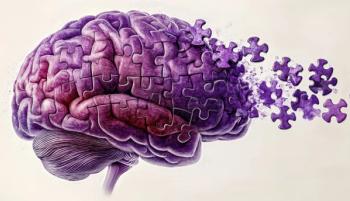
REM Sleep Behavior Disorder: Harbinger of Synucleinopathies?
An unfavorable prognosis may be in store for patients who report severely disrupted sleep patterns accompanied by rapid eye movement (REM).
An unfavorable prognosis may be in store for patients who report severely disrupted sleep patterns accompanied by rapid eye movement (REM). Typically, these patients-mostly older men (80% to 90%)-thrash, strike out aggressively, and shout as if acting out their dreams, and they also vividly recall their dreams when awakened.1 The diagnosis is REM sleep behavior disorder (RBD), a parasomnia characterized by loss of normal sleep atonia during REM accompanied by prominent motor activity and dreaming. Because neurodegenerative diseases-specifically synucleinopathies such as Lewy body dementia (LBD), Parkinson disease (PD), and multiple system atrophy (MSA)-develop in many patients with RBD, these diseases and RBD and are thought to have a common pathogenesis. Indeed, RBD may be prognostic for the development of these neurodegenerative diseases.2,3
Findings from a retrospective study published in the July 2006 issue of Lancet Neurology revealed that a neurodegenerative disorder developed in 45% of patients (20 of 44) a mean of 11.5 years after RBD symptom onset.4 PD was diagnosed in 20% of patients, LBD in 14%, and MSA in 2%. In addition to concluding that RBD may be a harbinger of neurodegenerative disorders, the study's authors commented that close follow-up of affected patients could enable early detection of neurologic problems.
Important diagnostic features of RBD include complex vigorous movements of the body or limbs or excessive jerking, vivid recollection of dream content, and polysomnographic evidence of increased submental or limb tone (phasic or tonic) based on electromyography during REM sleep.5
Motor symptoms of RBD include kicking, punching, and crying out, all of which suggest degeneration of the nuclei in the pontine tegmentum and medulla. Neuronal deposition of alpha-nuclein proteins, a hallmark of LBD, PD, and MSA, appears to play a role.6
RBD AND SYNUCLEINOPATHIES
RBD is strongly linked to the synucleinopathies,7,8 which are insidious: these disorders can emerge years and even decades before characteristic parkinsonian symptoms or cognitive impairments manifest.7 Alpha-nuclein, an aggregated protein consisting of 140 amino acids, pervades brain tissue, is concentrated at presynaptic terminals, and is extensively nitrated in the brains of persons with PD, LBD, and MSA.
In MSA, the oligodendroglial inclusion bodies are the most distinctive neuropathologic feature. The formation of these inclusion bodies may explain the selective loss of oligodendroglia and of neurons. The inability of the oligodendrocytes to degrade alpha-nuclein proteins, which they produce at low levels, may be responsible for the abnormal subcellular aggregation and clumping found in MSA.1
Bradley F. Boeve, MD, associate professor of neurology and chair of the Division of Behavioral Neurology at the Mayo Clinic in Rochester, Minnesota, and colleagues have done much work to demonstrate that RBD is associated with PD, MSA, LBD, frontotemporal dementia, primary progressive aphasia, and spinocerebellar atrophy type 3, as well as certain tauopathies, including supranuclear palsy and Pick disease.8
Their studies show that a common characteristic of neurodegenerative diseases in persons with RBD is the presence of alpha-synuclein-positive intracellular inclusion bodies.8 These findings suggest that RBD may be symptomatic of an underlying synucleinopathy. The researchers noted that RBD does not appear to be associated with Alzheimer disease (AD) except in complex cases in which Lewy bodies are present.
"A remarkably consistent observation over the years is that RBD is a precursor to neurodegenerative diseases such as PD, LBD, and MSA. Of course, RBD is not present in all patients with synucleinopathies, but it is common, and it is rarely associated with tauopathies," explained Boeve in an interview with Applied Neurology.
"There is a clear linkage between neurodegenerative disease and the synucleinopathies," agreed David G. Harper, PhD, associate director of geriatric research at McLean Hospital in Belmont, Massachusetts. "What we should focus on here is the pattern of the damage seen in PD, MSA, and LBD compared with that of the tauopathies, such as AD and progressive supranuclear palsy. The alpha-synuclein proteins seem to aggregate in the neurons, particularly in PD and LBD, and in high concentrations in the substantia nigra."
RBD, PD, AND LBD
Many patients in whom either PD or LBD is newly diagnosed have a history of RBD.6,9 "Five years after seeking medical help for RBD symptoms, 45% of elderly patients progress to either PD or LBD," Harper remarked. Incidence of RBD has been reported at 15% to 33% in cases of PD,10 and Boeve and coworkers found Lewy body pathology in 83% (15 of 18) of autopsy cases of patients with RBD and dementia in the absence of parkinsonian symptoms.8
A proposed explanation for RBD in association with LBD is the loss of neurons in monoaminergic brain stem nuclei-particularly those in the locus coeruleus and substantia nigra-that causes decreased inhibition of the cholinergic pedunculopontine nucleus, which is the mediator of sleep atonia. In addition to being a useful treatment for LBD, cholinesterase inhibitors have been shown to reduce symptoms of RBD in some patients.9
RBD AND MSA
REM sleep without atonia, a variant of normal sleep in which muscle tone is present during REM, was first reported in patients with MSA in the 1970s.11 During the ensuing 3 decades, the association with its pathologic variant-RBD-and MSA has become firmly established. The distribution of neurodegeneration is generally more widespread in MSA than it is in PD, and it is generally characterized by atrophy of the pontine structures that are responsible for the phenomenon of REM-sleep muscle atonia.11 The most important early discriminator between MSA and PD is the poor response to levodopa in patients with MSA. These patients, mostly female, often exhibit disrupted sleep with REM phase alterations and may present with frank RBD.1
TREATMENT STRATEGIES
RBD may well become a bellwether for identifying patients before neurodegenerative motor symptoms develop, thus potentially allowing for early intervention in neurodegenerative disease,11 although preventive treatments for RBD and synucleinopathies currently are lacking.
"At this point, we unfortunately do not have any available treatments that will delay the onset or prevent the progressive degeneration related to the synucleinopathies,"explained Boeve. "Coenzyme Q10, a rather benign over-the-counter preparation, has been found to slow the rate of progression of RBD to PD. There is no actual proof that coenzyme Q10 works, but since it requires no prescription, it is an agent that people with idiopathic RBD might try. Unfortunately, no proper dosage has been established."
"Worldwide use has shown that clonazepam is by far the best agent for the treatment of RBD," said Boeve. "It almost always works, even at very low doses such as 0.25 mg or 0.5 mg. Even a dosage as high as 1 mg per night is effective in almost 90% of patients. No one really understands why clonazepam works so well. It not only suppresses the vivid acting out while dreaming, but also helps to quell other bothersome nocturnal manifestations, such as the nasty nightmares that appear to reflect chasing and attacking themes."
Boeve added that, in his experience, melatonin is also useful by itself or in combination with clonazepam. Although it is not as effective as clonazepam, he said that he gives a trial of melatonin to patients with dementia before trying clonazepam because clonazepam has been associated with adverse effects on cognition. "[Dosages of] melatonin between 3 mg and 12 mg per night works at least half of the time," he said.
"We also have had some success with ramelteon [Rozerem], which is a new melatonin receptor agonist, and it seems to be effective especially in refractory cases," Boeve continued. Alternative treatments recommended by Boeve include quetiapine (Seroquel) and sodium oxybate (Xyrem), although he cautioned that impaired cognition is an adverse effect of the latter. "Overall, I would rank clonazepam as number 1 in treating RBD and melatonin as number 2, followed by a smattering of other medications that can be tried on an individual patient basis," he concluded.
REFERENCES
1. Geser F, Colosimo C, Wenning GK. Multiple system atrophy. In: Beal MF, Lang AE, Ludolph AC, eds. Neurodegenerative Diseases: Neurobiology, Pathogenesis and Therapeutics. New York: Cambridge University Press; 2005:623-662.
2. Abbott A. Neuroscience: while you were sleeping. Nature. 2005;437:1220-1222.
3. Boeve BF, Silber MH, Ferman TJ. REM sleep behavior disorder in Parkinson's disease and dementia with Lewy bodies. J Geriatr Psychiatry Neurol. 2004;17:146-157.
4. Iranzo A, Molinuevo JL, Santamaria J, et al. Rapid-eye-movement sleep behaviour disorder as an early marker for a neurodegenerative disorder: a descriptive study. Lancet Neurol. 2006;5:572-577.
5. Ferman TJ, Boeve BF, Smith GE, et al. REM sleep behavior disorder and dementia: cognitive differences when compared with AD. Neurology. 1999;52:951-957.
6. Postuma RB, Lang AE, Massicotte-Marquez J, Montplaisir J. Potential early markers of Parkinson disease in idiopathic REM sleep behavior disorder. Neurology. 2006;66:845-851.
7. Boeve BF, Saper CB. REM sleep behavior disorder: a possible early marker for synucleinopathies. Neurology. 2006;66:796-797.
8. Boeve BF, Silber MH, Parisi JE, et al. Synucleinopathy pathology and REM sleep behavior disorder plus dementia or parkinsonism. Neurology. 2003;61:40-45.
9. Relkin N. Dementia with Lewy bodies. In: Beal MF, Lang AE, Ludolph AC, eds. Neurodegenerative Diseases: Neurobiology, Pathogenesis and Therapeutics. New York: Cambridge University Press; 2005:473-480.
10. Silber MH. Parkinson's disease. In: Lee-Chiong T, ed. Sleep: A Comprehensive Handbook. Hoboken, NJ: Wiley; 2006:789-792.
11. Gagnon JF, Postuma RB, Mazza S, et al. Rapid-eye-movement sleep behaviour disorder and neurodegenerative diseases. Lancet Neurol. 2006;5:424-432.
CHARLES J. IPPOLITO, MD, is a freelance medical science writer in New York City.
Newsletter
Receive trusted psychiatric news, expert analysis, and clinical insights — subscribe today to support your practice and your patients.













